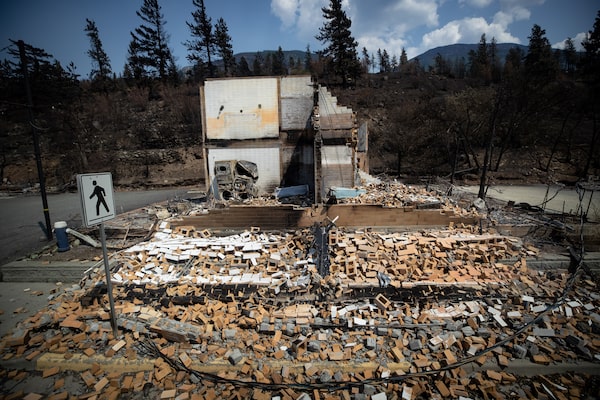
A damaged structure is seen in Lytton, B.C., on July 9, 2021, after a wildfire destroyed most of the village on June 30.DARRYL DYCK/The Canadian Press
The wildfire that engulfed the community of Lytton, B.C., last summer approached fast and simultaneously from four fronts, leaving no realistic chance that firefighters could have prevented the destruction and loss of life, a forensic investigation concludes.
But the summary report by the Institute for Catastrophic Loss Reduction gives British Columbia a failing grade for its approach to wildfire emergency response, because it has put too much emphasis on suppressing fires, and not enough on creating “ignition-resistant” communities.
The Lytton Creek fire started on June 30, in the middle of a record-breaking heat wave, including the Canadian record high of 49.5 C on June 29. The heat created strong winds channelled through the steep slopes of the Fraser River canyon.
Alan Westhaver, one of the authors of the report, said the Lytton fire matches the same pattern as other wildfire disasters in North America. These wildfires, fed by dry fuel and high winds, become catastrophic when they intersect with urban settings with too many ignition sources.
“For a long time, we have looked at fire as the enemy, but fire is an inherent part of ecosystems,” he said in an interview. “Whether it’s grassland in southern Saskatchewan, the bush in Northern Ontario or the different kinds of forest in the mountains, we’ve created this paradox where, by putting out fires, we are building up more fuel and creating the conditions for hotter fires that are more difficult to control.”
The future of wildfires in Canada
Disasters such as Lytton are not inevitable, he said, if vulnerable communities curb the amount of combustible material around buildings. “The reason that homes and structures ignite, is the conditions that are found within 30 metres of those homes.”
Kelsey Winter, chair of the BC FireSmart Committee, said the Lytton Creek fire needs to propel change. “Lytton is not an anomaly – any community in B.C. could be Lytton.”
The report does not pinpoint the cause of the fire, but concludes that there were a series of ground fires that spread out of a small basin near the CNR tracks south-southwest of Lytton Village, creating a blizzard of burning embers. Last October, the Transportation Safety Board ruled out trains as a cause of the fire.
Fed by high winds and an abundance of dry fuel on the ground, the fire quickly spread between structures because homes and shops were built close together, with highly ignitable sheds and other outbuildings in between.
Less than an hour after the fire was first reported, more than 20 structure fires were burning in the village and in two neighbouring Lytton First Nation reserves. Two people died in the fire, and hundreds of people remain displaced.
“The rapid, simultaneous fire involvement of this many primary structures would have overwhelmed any reasonable municipal structure protection response in that region,” the report found. “For individual structures and collectively communities, ignition resistance is the most effective approach for reducing community wildfire risk and preventing [wildland-urban] fire disasters.”
Lytton Mayor Jan Polderman said Monday that the village council is working to ensure that when the town does rebuild, it will be a model “fire-smart” community.
The fire debris is still being cleared, but he hopes that by September, construction can begin with new bylaws in place that will ensure homes are built with fire-resistant materials, and with regulations to keep combustibles a safe distance away from homes, including vegetation, sheds and wood piles.
He said his community needs help to make those changes. “My frustration right now is that our emergency services pay you to rebuild what you had, not what we’re going to need in the future,” he said. “What I would like to see is the province and the federal government encourage homeowners to build in building envelopes that are more fire resilient.”
British Columbia has had its three worst wildfire seasons on record in the past five years, and climate change means it needs to prepare for more extremes, Ms. Winter noted. “There are those things we can’t control, like the winds and the weather and how the climate is affecting wildfire behaviour. But the things we can control are within communities and on the land base.”
Property owners, she said, can remove vegetation and other ignitable materials adjacent to their buildings, for example, and they can choose non-flammable siding and roofing materials. But it is also a question of where homes are rebuilt.
“You want to make sure there is non-combustible space right between homes, and if they’re smack next to each other, that’s very difficult to do,” she said.
We have a weekly Western Canada newsletter written by our B.C. and Alberta bureau chiefs, providing a comprehensive package of the news you need to know about the region and its place in the issues facing Canada. Sign up today.